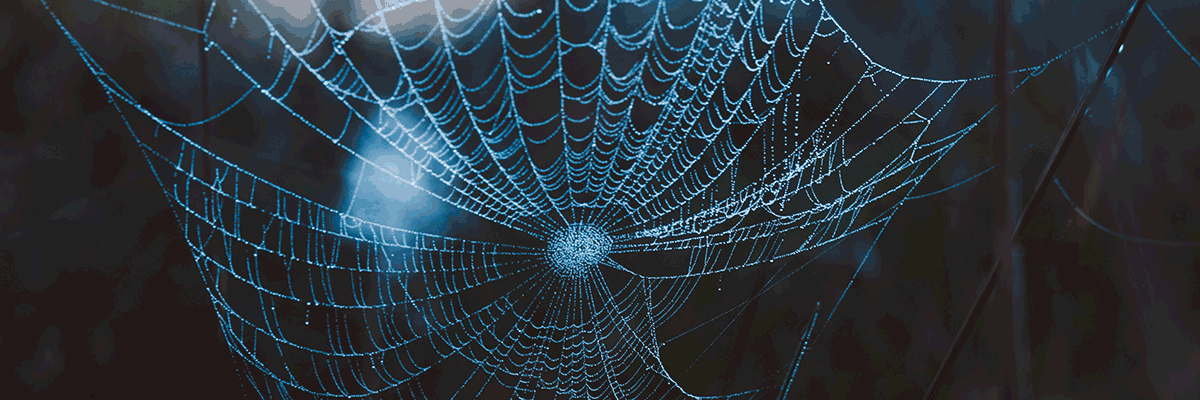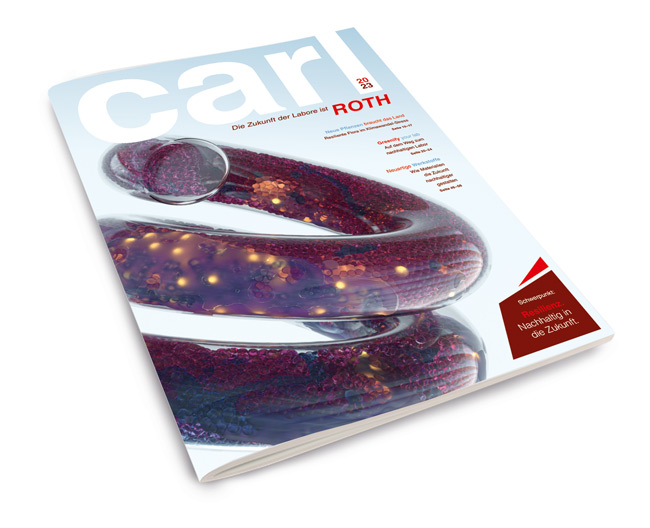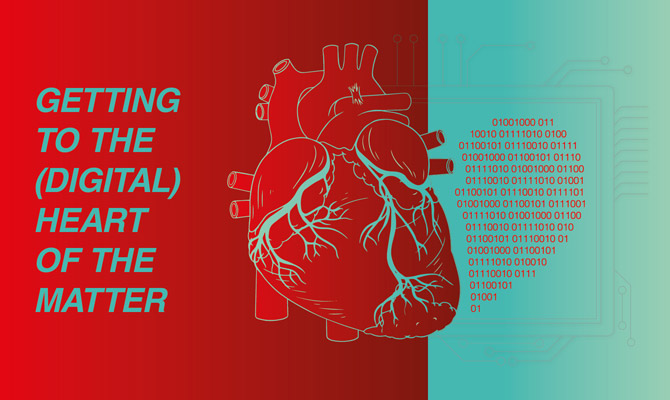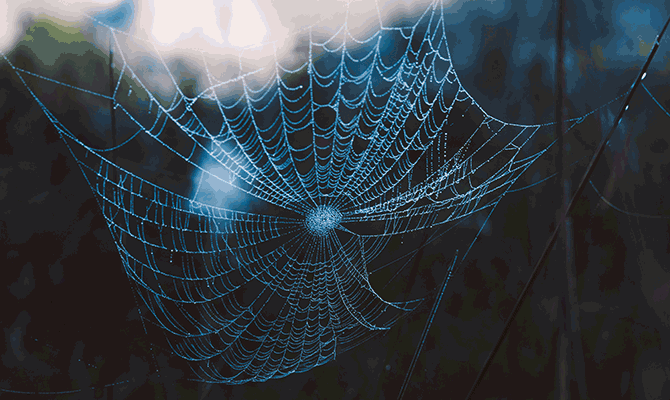
Spider silk for injured hearts and eco-friendly running shoes
The silk that spiders produce to spin their webs is also a useful high-performance material for us humans. Researchers have already tested spider silk for use in biodegradable textiles and compatible medical implants. But how many spiders does it take to spin a piece of fabric?
The morning dew makes this otherwise near-invisible work of art glisten in the light like a silver necklace. Glistening beads tremble in the morning breeze, precariously attached to the most delicate threads that one fears may break at any moment …
But they hold firm. Because spider webs not only look impressive, they are also a prime example of natural high-performance materials. After all, the spider has to trap insects mid-flight in its intricate web without its prey shooting right through the trap like an arrow. Spiders have mastered this task over millions of years of evolution. Although their silk is so fine that just 320 grams of it would be enough to stretch a thread once around the Earth, many of their prey don’t stand a chance against the spider’s web. [1] Spider silk combines high elasticity with high tensile strength, making it many times stronger than steel. If a rope with a diameter of one centimetre could be made from spider silk, it would only break under a load of eight tonnes – in other words, it could easily hold five mid-range cars. [2]
What spiders seem to effortlessly weave into intricate insect traps has posed a challenge to researchers for decades. Only with the modern methods of analysis of this millennium has it been possible to unravel the vital secrets of spider silk.
A multifaceted high-performance composite material
We now know that spider silk consists of different types of proteins, the combination of which defines the properties of the threads. Spiders can produce up to seven different types of thread. The radial threads of a spider’s web, for example, are made of proteins, which are mainly arranged together like stacked sheets. Although this makes them comparatively inflexible, the structures are particularly stable. The sticky elastic threads in the centre of the web, on the other hand are mainly based on spirals, or spirally wound proteins, which makes them more tensile and tearproof. By specifically combining the different proteins, the spider is able to adapt the macroscopic properties of its silk – it essentially produces a high-performance composite material. [2]
It therefore comes as no surprise that many brilliant minds have tried to harness the benefits of spider silk for human use. However, unlike caterpillars of the silkworm (Bombyx mori), spiders are not suitable for breeding as they are predominantly cannibalistic and can only be kept in small groups. And even though it is possible to obtain the spiders’ silk by ‘milking’ them, this involves enormous effort. In the Victoria and Albert Museum in England, for example, there is a scarf made of spider silk measuring around two square metres, but it took 75 workers four years to collect and milk over 1.5 million spiders to obtain enough silk to make this one item. [7]
Under these conditions, for a long time the industrial use of spider silk was simply impossible. From around the 1980s, efforts therefore began to take shape to transfer the genetic code for the production of spider silk to other organisms such as bacteria or yeasts in order to use them to produce the coveted material – and many years of research finally led to success. [3]
The first spider silk from the laboratory …
The “first biotechnologically produced spider silk thread with mechanical properties identical to those of natural fibres” [4] is the result of a collaborative research project involving a team led by Dr Thomas Scheibel from the University of Bayreuth. In 2013, in partnership with the company AMSilk, the scientists produced artificial spider silk – which they called ‘Biosteel’ – using genetically modified E. coli bacteria. Thanks to a specially developed process, it has been possible to adapt the properties of artificial spider silk to the desired applications on an industrial scale, for example for medical and pharmaceutical products, cosmetics, composite materials and technical textiles. [4] [5]
… ended up in a shoe!
The developers report that the fibres produced in this way are up to 15% lighter than conventional synthetic fibres and are said to be 25 times more resilient than a comparable steel wire. According to researchers, the fibres can also be dyed using standard dyeing techniques, which makes them of particular interest to the textile industry. The material also fulfils the requirements for the definition of biodegradability according to OECD standard 301B, i.e. it can be defined as ‘readily biodegradable’. [3] In 2016, the sports goods manufacturer Adidas used this material to produce a running shoe with an upper made entirely from ‘Biosteel’ fibres which made it biodegradable. [10] The prototype was presented at the Biofabricate Summit in New York, but was ultimately never marketed. For its part, AMSilk, is now supplying the automotive industry with fabrics made from biotechnologically produced spider silk protein, which are to be used for the interiors of future luxury cars. [11]

You can find more interesting
novel and resilient materials in carl 02
An ‘Invisible’ Coating for Implants
The fashion industry may still be waiting to see a new trend in spider silk fabric, but the signs are more promising in another industry. In 2017, researchers from the Universities of Bayreuth and Erlangen-Nuremberg successfully produced spider silk protein and cultivated connective tissue cells and blood vessel cells on it. In the long term, it should be possible to generate functional heart tissue in this way. [6]
A major advantage of spider silk is its antibacterial effect. It was used in ancient times for wound dressings thanks to its natural antiseptic properties, as Dr Thomas Scheibel from the University of Bayreuth reported in an interview with radio station SWR. Most spider silks are also virtually invisible to the immune system and do not cause any rejection or inflammatory reactions. This makes them ideal candidates for medical applications, such as bone and cartilage replacement and the regeneration of soft tissue such as heart muscle, skin or nerves. [7] Scientists have already made silicone implants biocompatible in initial trials by coating them with spider silk protein: the body’s immune system is fooled by the biocompatible spider silk on the surface of the implant and there is no undesirable immune response. [8]
Conclusion
Currently, researchers are still mainly using naturally obtained spider silk for such experiments. While this procedure is reasonably time-intensive for scientific studies, industrial applications are absolutely dependent on the technical production of the spider silk proteins described above. Research has already shown that such production is possible – the task now is to further optimise the processes and enable profitable, large-scale industrial production.
In February of this year, scientists published a study on spider silk protein threads produced using an artificially manufactured spinneret, using a spider silk protein solution to produce a fibre very similar to that of living spiders. [9] And the cosmetics industry is already using biotechnologically produced spider silk proteins in luxury creams. If production can be scaled up cost-effectively, many areas of our everyday lives could benefit from the outstanding properties of spider silk in the future, whether in sports shoes, cosmetics, architecture or medical implants.
Video Suggestions:
Warum Spinnenseide so besonders ist | Terra X plus (Youtube)
Thomas Scheibel – Künstliche Spinnenseide (Youtube)
Sources:
[1] https://www.swr.de/swr2/wissen/article-swr-11664.html
[2] https://www.int.fraunhofer.de/content/dam/int/de/documents/EST/EST0514S106.pdf
[3] https://www.kunststoffe.de/a/news/die-natur-als-vorbild-kuenstliche-spinne-267262
[4] https://www.presse.uni-bayreuth.de/de/archiv/2013/050-Hochleistungsmaterialien-Spinnenseide.pdf
[5] https://www.munich-startup.de/57476/amsilk-success/
[6] https://www.derstandard.at/story/2000062644204/mit-spinnenseide-zum-kuenstlichen-herzmuskelgewebe





